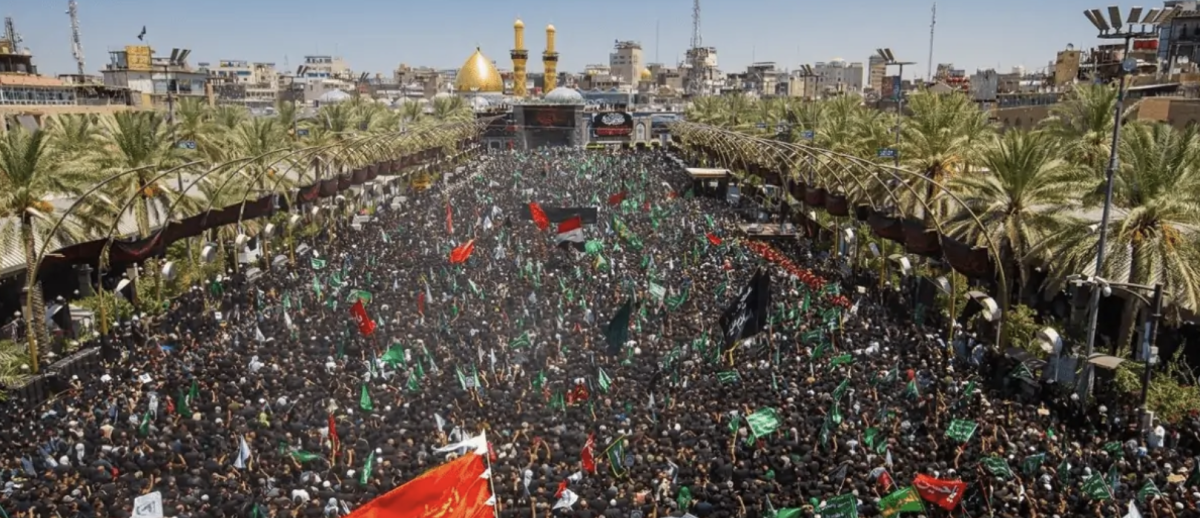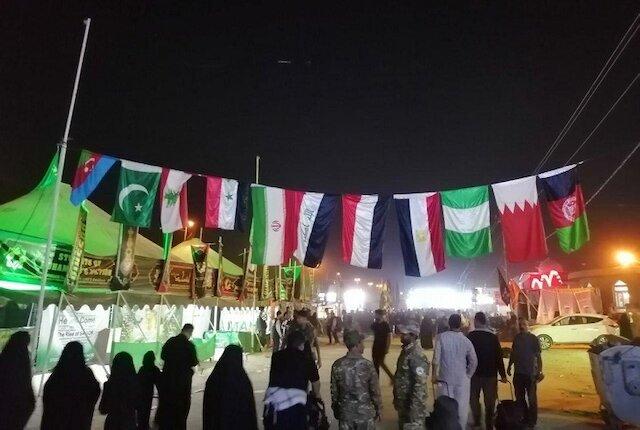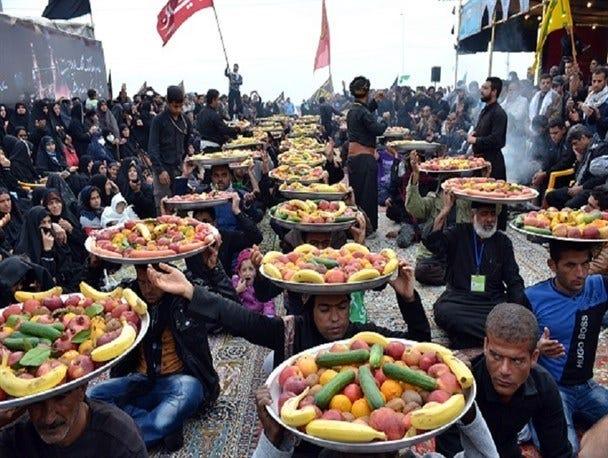Arbaeen Walk: From Sectarian Ritual to Global Pilgrimage - Modification in Interpretation & Function
archive


Mourners converge on the holy city of Karbala in Iraq. (Photo: Twitter, Husain Hajilari)
Arbaeen Walk: From Sectarian Ritual to Global Pilgrimage - Modification in Interpretation & Function
The Arbaeen Walk stands as the largest global pilgrimage, an annual tradition observed by Shia Muslims in Iraq following a 40-day mourning period for Hussain, the third Imam of Shia Muslims and the grandson of Prophet Muhammad. The Arbaeen Walk is a complex phenomenon that, at first glance, appears to be a collective religious pilgrimage. However, it is a multi-layered phenomenon, ranging from a cultural event to a socio-political affair. The history of this pilgrimage has two main phases: before and after the US invasion in 2003. Before the US invasion, it had a sectarian meaning for Shias. After 2003, the meaning of this ritual changed from sectarian significance to a spectrum of collective cultural rituals and Shia internal discursive conflicts.
Shia, constituting 10% - 15% of the global Muslim population, forms one of the two main sects of Islam, the other being Sunni. Shia recognize an Imam as the prophet's successor, and a significant aspect of their faith involves visiting the shrine of their Imams. An Imam is a religious leader whom Shia Muslims believe is a spiritual and political leader, chosen by God to guide the Muslim community. The Imam is seen as an infallible and authoritative figure in matters of faith and interpretation of Islamic teachings. During the Arbaeen Walk, pilgrims embark on an approximately 80km journey from Najaf, a southern Iraqi city where the first Imam of Shia is interred, to Karbala, Hussain's final resting place. This pilgrimage typically spans three to five days. Upon reaching the shrine, participants solemnly pledge allegiance before making their journey back home.
According to Iraqi governmental reports, the collective ritual in 2018 drew a staggering participation of over 20 million pilgrims. While the majority of participants originated from Iraq, Iran, Pakistan, and Bahrain, the event saw representation from more than 29 nationalities, including European Muslims and occasionally Christians and Jews (Annual Statistical Bulletin 2018). Notably, the Arbaeen Walk is the largest annual international pilgrimage today, surpassing the attendance of Islam's Hajj, Christianity's Santiago de Compostela, and India's Kumbh Mela.

flags of various nationalities present at the Walk (photo: Hawzah News Agency)
In Shia narratives, the historical roots of the Arbaeen Walk trace back to the era of the Umayyad and Abbasid dynasties, originating in the first year after the Battle of Karbala (AH 61/AD 680). Subsequently, Islamic scholars (Ulama) began the practice of walking to Imam Hussain's shrine 40 days after his martyrdom. The history of the Arbaeen Walk can be delineated into two significant eras: pre-2003 and post-2003. Before 2003, this ritual faced prohibition under Sunni rulers and later under the secular Baathist regime. As a minority, Shias encountered numerous challenges, including arrests, torture, and life sentences, for participating in the Arbaeen Walk. It served as a submassive sectarian ritual for Shias, symbolizing their opposition to Sunni dominance. Despite the Baathist regime identifying as secular, Saddam Hussein, a Sunni leader, marginalized the majority Shia population (Ali 2000). An illustrative instance was the imposition of restrictions on Shia rituals, including the Arbaeen Walk. The pre-2003 period witnessed several violent incidents during the Arbaeen Walk in Iraq, notably in 1970, 1975, and 1976, where military forces used force to prevent pilgrims from engaging in this ritual (Mazaheri 2016).
After the U.S.-led invasion and occupation of Iraq in 2003, the Ba'ath regime was ousted, leading to the rise of Shia influence. The previously imposed restrictions on the Arbaeen Walk were lifted, granting Shias from Iraq and around the world the freedom to participate in this pilgrimage without hindrance. However, with the removal of the submassive sectarian meaning and opposition, this pivotal ritual faced a moment of redefinition and reinterpretation, requiring a new purpose to motivate participants. The Arbaeen Walk transitioned into a cultural ritual, serving to unite the Shia community and showcase Shia power on a regional and global scale. Beyond being a cultural collective event, it evolved into a representation of cohesion and conflict within Shia Muslim discourses.
At first glance, the Arbaeen Walk may appear as a peaceful, cohesive collective action involving millions of people. However, it also becomes a platform where conflicts within the Shia community, ranging from religious to political issues, are brought to the forefront. This shift in the representation of Shia conflicts within the Arbaeen Walk occurred as Shias lost their motivation for maintaining a cohesive identity against Sunnis in Iraq. Over the decade following Iraq's invasion, enhanced security measures facilitated the participation of individuals from diverse nationalities in the Arbaeen Walk. This period witnessed the expansion of Iraqi cultural traditions, with a particular focus on providing various services to pilgrims. A significant milestone occurred in 2008 when Iranians collaborated with Iraqis, actively contributing as hosts and service providers for the pilgrims. During the second decade post-invasion, the pilgrimage experienced a remarkable surge, drawing 20 million pilgrims from 29 nationalities. In the years following 2003, individuals from diverse cultures began offering various food options, along with additional services such as sleeping accommodations, bathrooms, showers, snacks, beverages, and even massages. Hosts from different countries took it upon themselves to provide these services to the pilgrims.
The essence and purpose of this ritual underwent a complete transformation, evolving into a cultural carnival. Drawing inspiration from Mikhail Bakhtin's perspective, a carnival is a socio-political setting devoid of societal hierarchy. Participants in the carnival do not see themselves as a mass; instead, they perceive a sense of belonging to a classless, cohesive group engaged in collective action that can challenge prevailing governmental or socioeconomic powers (Badarneh 2011). The Arbaeen Walk, functioning as a classless ritual, empowers participants to challenge the conventional hierarchy in their daily lives. Anticipated throughout the year, individuals eagerly prepare for this ritual, establishing serving stations and readying food and services as hosts along the entire route, particularly the Najaf-Karbala stretch, resembling a vibrant carnival.

Locals carry food on their heads to welcome the pilgrims. (photo: Beingzab.wordpress)
Participants in mass actions often form new connections and communications. Stephen Reicher contends that mere physical presence in a crowd doesn't automatically create connections or a collective sense of communication. However, engaging in mass actions with a shared identity can facilitate the establishment of new connections and communications, fostering trust and mutual respect. The outcomes of such actions can vary, influenced by factors like a common identity or shared actions (Reicher 2011).
The Arbaeen Walk exemplifies one such mass action where participants, bound by their shared Shia identity, engage in cooperation and collective endeavors. During the Arbaeen Walk, Shias from diverse backgrounds seize the opportunity to share their identities. Their similarities contribute to cooperation and trust-building, while their differences foster mutual respect. The connections forged among pilgrims extend beyond the two weeks of rituals and permeate their lives. Iraqi government statistics reveal that marriages, friendships, and business connections frequently emerge among participants of different nationalities after each Arbaeen Walk (Annual Statistics Bulletin 2018). However, it's essential to recognize that the cohesive image of the Arbaeen Walk is not the sole reality of this ritual. Like other cultural phenomena, the Arbaeen Walk comprises various layers, serving as an arena for discursive conflicts and power relations. In essence, it represents the reality of Shia cohesion and conflict, as mentioned earlier.
The Arbaeen Walk is a complex phenomenon, with its external layer demonstrating cohesion among Shias from various contexts. This cohesion is driven by both shared similarities fostering cooperation and differences facilitating mutual acceptance. However, its internal layer is shaped by power relations within the Shia community, marked by discursive competitions. Within Shia Islam, multiple schools of thought and discourses exist, each led by distinct leaders and followed by dedicated adherents. These revival discourses share commonalities, such as a belief in Islam and Shia as the rightful faith. In pre-invasion Iraq, the Arbaeen Walk primarily symbolized sectarian identity. However, in the post-invasion era, internal discursive conflicts have surfaced. Each discourse revolves around a nodal point, such as nationalism, traditionalism, extremism, or Shiism, and seeks historical dominance in a manner aligned with its nodal point.
For instance, the discourse rooted in nationalism opposes the intervention of other nationalities in hosting the Arbaeen Walk, fearing external powers like the Iranian government may appropriate it. This concern is reflected in their post-invasion policy to reduce foreign intervention in Iraq. Conversely, the discourse aligned with Shiism is that it has a recognized leader—the Islamist government of Iran. The Iranian regime, driven by the goal of expanding Shia doctrine, particularly the narrative of the Islamic Republic of Iran, views the Arbaeen Walk as an annual opportunity to promote its ideology. The confiscation of this ritual is perceived as a threat, prompting significant expenditures on propaganda efforts (VOA 2023). Along the routes of the Arbaeen Walk, images of leaders from these discourses are displayed, depicting followers tearing down banners of opposing leaders.

ripped banner of Ayatollah Seyed Sadeq Shirazi (photo: adyannews.com)
Hence, the largest collective annual ritual and international carnival transcended its status as a mere cultural phenomenon connecting diverse communities. It evolved into an opportunity for various discourses to propagate their ideologies and bolster their influence. The Arbaeen Walk stands as a representative of both cohesion and conflict within the Shia community. It is a multi-dimensional phenomenon that, on a mass level, embodies people's aspirations to partake in a classless, cooperative atmosphere reminiscent of a Carnivalesque situation. The masses engaged in this distinctive sociocultural experience are mobilized by religious authorities representing different competitive discourses.
Graduate Student of Religious Studies, University of California-Santa Barbara, soodehmansouri@ucsb.edu
Al-Ali Nadge Sadig. 2000. Iraqi Woman, untold stories from 1948 to present. London & New York: Zed Books.
Annual statistical bulletin. النشره الاحصایه السنویه. 2018. Iraq Government
Badarneh A. Muhammad. 2011. “Carnivalesque politics: A Bakhtinian Case study of contemporary Arab polite humor.” International Journal of Humor Research.
DOI: http://dx.doi.org/10.1515/humr.2011.019
Fotini Christia, Elizabeth Dekeyser, Dean Knox. 2016. “To Karbala: Surveying Religious Shi’a from Iran and Iraq.” Massachusetts Institute of Technology https://web.mit.edu/cfotini/www/Shia_Pilgrims_Survey.pdf
Mazaheri Mohsen Hessam. 2013. “Shiite Mourning Culture”. Tehran: Arma Publication.



